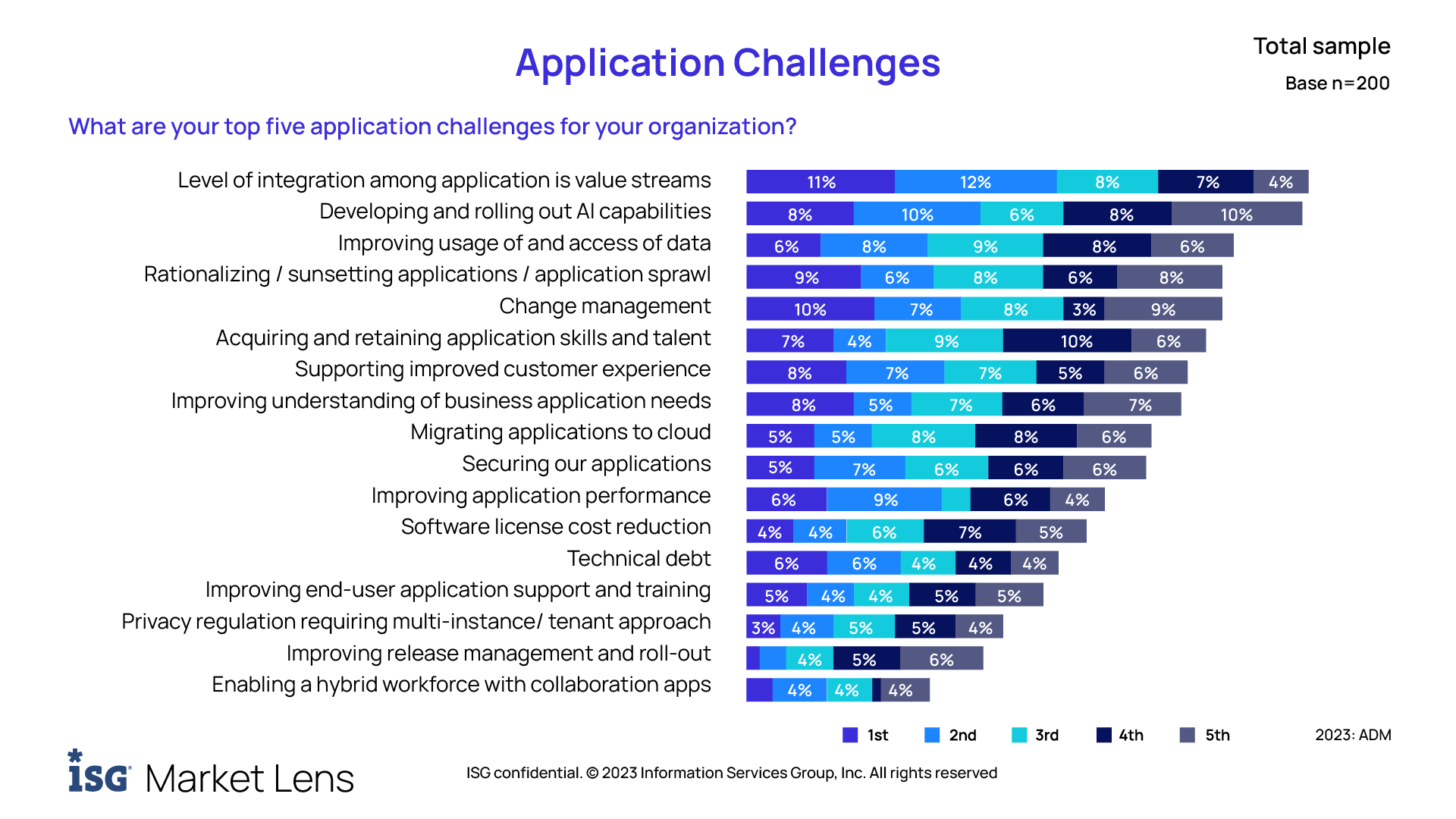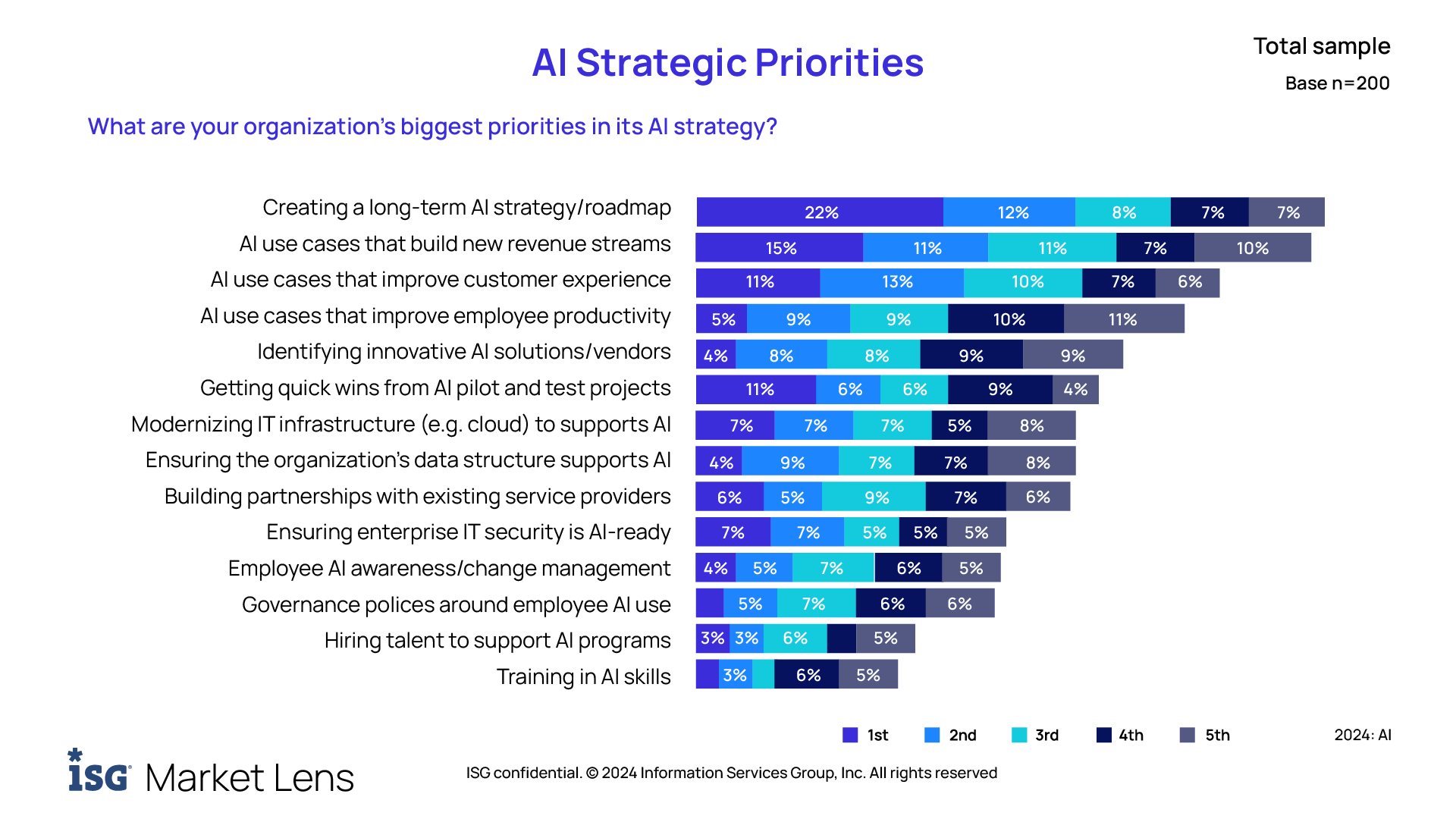In the modern digital landscape, the rapid advancement of artificial intelligence (AI) is driving organizations to reevaluate and enhance their data infrastructures. To fully leverage AI’s potential, enterprises need a robust and scalable data infrastructure that can handle large volumes and varieties of data, enable fast processing and analysis, and support experimentation and innovation.
Our blog post explores the significance of data modernization in today’s competitive environment. It highlights its evolving role in upgrading data infrastructure and adopting new technologies to boost data usability. We will examine the benefits of data modernization, strategies for successful implementation, and real-world case studies demonstrating its transformative impact across different industries.
Often, enterprises accumulate data in isolated systems or departments, leading to data silos. Data modernization efforts typically focus on integrating data from various sources into a centralized repository or data lake, which opens the doors to an ocean of data benefits, including today’s most critical goal: AI-readiness. But to understand the impact of its advantages, we first need to understand it better.
What is Data Modernization and its Tenets?
Data modernization involves upgrading the fundamental infrastructure, tools, and practices to align with the dynamic demands of data-centric business operations and analytics.
With multiple definitions out there, here’s a simpler way to understand data modernization. Imagine it as the renovation of a house—you’re updating the wiring, plumbing, and layout to make it more efficient and suitable for modern living.
It’s like rewiring the outdated electrical system to handle more appliances, replacing old pipes with modern ones to improve water flow, and reconfiguring room layouts for more comfort.
Similarly, in data modernization, enterprises upgrade their data storage, processing, and analysis capabilities to accommodate the growing volume, variety, and velocity of data.
Data Infrastructure
Data infrastructure refers to the comprehensive components that collectively enable data consumption, storage, sharing, and management within an enterprise. This encompasses not only the physical hardware and software systems but also the networking infrastructure, data services, governance policies, and security measures.
Modernization of the data infrastructure includes transitioning from traditional data warehouses to cloud-based storage solutions, implementing advanced data processing frameworks, and adopting modern analytics tools for actionable insights. Just as a renovated house enhances comfort, convenience, and efficiency for its occupants, data modernization enhances accessibility, security, and utilization of data—powered by enhanced data aggregation, storage, and retrieval.
Each step and action contribute to modernizing data infrastructure and practices. While they may not individually represent data modernization, they collectively lay the groundwork and pave the way for achieving modernized data capabilities.
Data Assets
When we look at how data modernization affects data assets for the modern business, we are referring not to a cosmetic upgrade but rather a fundamental overhaul that involves redefining data structures, enhancing data quality, implementing the benefits of advanced analytics, and AI-powering attributes.
This holistic approach ensures that data goes beyond being just a storage of information to becoming a vital strategic asset driving decisions and fostering innovation. Data assets encompass a wide range of valuable information for organizations, including structured data, unstructured data, metadata, and other resources crucial for decision-making, operations, and strategic initiatives.
Unlike data infrastructure, which focuses on the hardware and software supporting data processing and storage, modernizing data assets involves transforming how data is used and understood. This transformation starts by tackling the issue of data fragmentation, where data is often stored in separate systems or departments, leading to inefficient data silos.
Regardless, getting started with any of the two data modernization initiatives involves dealing with the prevalent issue of data being stored in fragmented, isolated systems or departments, resulting in data silos. Data modernization efforts focus on consolidating data from multiple sources into a centralized repository or data lake. By dismantling these data silos and fostering a unified data ecosystem, organizations can significantly improve data accessibility and revisit strategies for advanced AI on the radar.
The Role of Data Modernization in the AI Race
The pressure to keep up with AI advancements is exposing underlying issues in enterprises’ ability to fully leverage AI’s potential. As enterprises race to integrate AI capabilities into their business applications, those with unmodernized data infrastructures are encountering significant challenges.
In the 2023 ISG Market Lens™ study on Application Development and Management, which surveyed 200 global leaders responsible for application projects and operations, “rolling out AI capabilities” came out as the top application priority (chosen by 55% of respondents). The study also brought to light a rise in ADM budgets—with app development rising faster (4.6% increase) than budgets for maintenance or resourcing (1.6% and 2.3% increase, respectively), likely due to the desire to augment AI.
However, as we can see in the infographic below, when asked about the top application portfolio challenges faced by their organization, study respondents chose integration of applications in their value stream as their top challenge, with the challenge of data usage and access taking its place in top three.
 Source: ISG Market Lens Application Development and Maintenance Study, n=200, Jan 2024.
Source: ISG Market Lens Application Development and Maintenance Study, n=200, Jan 2024.
The study reiterates a natural order. Applications are important for business’ value streams, AI is important for business applications, and optimal use of data is important for both. AI has already become an integral part of applications, and such AI applications will require pristine data to power them across the value stream.
A value stream is the path a product or service takes from start to finish, focusing on how each step contributes to meeting customer needs effectively. It’s about making sure everything flows smoothly, improving as you go, and working together across different parts of the company to deliver better outcomes. An area for AI to thrive.
Across the value stream, AI-powered business applications will be tasked with major improvements, such as evolving predictive maintenance in manufacturing, making hyper-personalized customer journeys more intuitive in retail, and achieving higher accuracy in real-time fraud detection in finance.
AI’s adaptive learning algorithms will continuously improve AI models by learning from new data, ensuring they remain accurate and relevant. Further, smart data tagging automatically categorizes and labels data for easier retrieval and utilization. All impossible without the right data foundation.
In essence, getting the trinity right is important – highly-functional business applications, new AI features for applications, and improved data usability. And, within multiple strategies to align these three challenges, data modernization is key. So, let’s explore its benefits and how to get it right.
Outdated Data, Outdated AI: Why Modernization Matters
Data modernization is the cornerstone of preparing for the next phase of AI innovation, where intelligent systems are set to drive unprecedented advancements in multiple industries. We believe that the convergence of data modernization and AI are two critical elements in shaping the future of business.
Where the next phase of AI is characterized by the seamless integration of AI into everyday applications and processes, this next phase transcends mere automation and moves towards intelligent decision-making, predictive insights, and hyper-personalized experiences.
Data modernization aids in preparing your data environment to fuel AI algorithms, providing the raw material for training, learning, and making informed decisions. The quality, quantity, and relevance of data directly impact the effectiveness and accuracy of AI applications.
The infographic below shows the results of the 2024 ISG Market Lens™ Artificial Intelligence Study, which asked 200 global leaders with authority over AI projects and applications in IT and the business about their organization’s main strategic goals for AI.
 Source: ISG Market Lens AI Study, n=200, Jan 2024
Source: ISG Market Lens AI Study, n=200, Jan 2024
42 percent of the participants in the ISG Market Lens™ Artificial Intelligence Study chose creating a long-term AI strategy or roadmap as their organization’s top goal, followed by 37 percent who aim to find AI use cases that generate new revenue streams, and 34 percent who focus on AI use cases that enhance customer experience.
Let’s explore how data modernization plays a pivotal role in addressing each of the top three key priorities identified by ISG:
- Creating a Long-Term AI Strategy or Roadmap: To plan and implement AI for the long term, data modernization is key. It ensures reliable, integrated, and high-quality data for training AI models and connecting different data sources. Modernized data platforms improve governance and security, ensuring compliance, protecting sensitive data, and keeping AI trustworthy. They enable advanced analytics, letting AI do predictive and prescriptive tasks, and support MLOps for smooth machine learning operations.
A modern data environment enables innovation and agility, allowing quick adjustment to business and tech changes. It also conserves resources, reduces storage and processing expenses, and enhances operational efficiency. Data modernization serves as a strategic catalyst for AI, delivering the quality, accessibility, governance, and scalability essential for sustained AI initiatives.
- AI Use Cases That Generate New Revenue Streams: Modernized data infrastructure provides the foundation for developing AI capabilities that drive new revenue streams. Building AI on top of structured and well-managed data, organizations can create innovative products, services, and business models that enhance competitiveness.
- AI Use Cases That Enhance Customer Experience: Data modernization enables availability for high-quality, integrated data, so businesses can understand customer behaviors and preferences better. Modern data platforms allow real-time analytics, which help companies offer personalized and timely interactions, important for increasing customer satisfaction. Strong data governance and security protect customer data, building trust and loyalty. Advanced analytics enable AI solutions like chatbots, recommendation engines, and predictive customer service, which make interactions easier and more effective. Data modernization gives businesses the ability to use AI for providing better customer experiences, keeping customers, and creating long-term customer relationships.
In essence, data modernization efforts establish a strong data foundation for your enterprise that fuels AI innovation, enhances operational efficiencies, and drives business growth in the digital age.
What are the Benefits of Data Modernization?
By understanding and leveraging the benefits of data modernization, organizations can position themselves for success in a data-driven and dynamic business landscape.
- AI-powered Intelligence Systems: Data modernization enables accurate, up-to-date, and clean data essential for AI-powered decision systems. Through AI-powered data analysis and interpretation, teams can extract valuable insights, recognize emerging trends, and make informed decisions that drive business success.
- Improved Operational Efficiency: By modernizing data processes, organizations can streamline data integration, cleansing, and consolidation, ensuring uniformity and high-quality data. This transformation enhances operational efficiency, optimizes workflows, and lowers costs associated with manual data handling and reconciliation.
- Superior Customer Experiences: Data modernization empowers businesses to deliver timely, relevant, and tailored offerings that align with customer expectations, thereby increasing satisfaction and fostering loyalty through personalized interactions, customized marketing strategies, and enhanced customer support.
- Stronger Security and Compliance: In industries such as pharmaceuticals, compliance with regulatory standards is paramount. Data modernization ensures data integrity, security, and traceability, facilitating compliance with stringent regulations such as FDA guidelines and data privacy laws. Its biggest upgrade is data transparency.
- Increased Agility and Innovation: Adapting to change with a flexible data infrastructure not only ensures increased agility and innovation but also empowers enterprises to quickly adjust to evolving market conditions and customer demands. By modernizing their data assets, businesses can harness the power of advanced analytics and AI.
Implementing a Data Modernization Strategy
A carefully planned approach to modernizing data can enhance data integrity, ease of access, and responsiveness, thereby fostering improved decision-making capabilities and gaining competitive edges. Outlined below are the key stages of a data modernization strategy.
Define Your Business Objectives
Initiate your journey by articulating specific objectives and goals. Clarify what you intend to accomplish, whether it’s enhancing data analytics, facilitating data-driven decisions, minimizing data silos, or bolstering data security.
Assess Your Data’s Current State
Perform a thorough evaluation of your current data infrastructure, processes, and capabilities. This involves:
- Mapping out existing data sources, types, and storage systems.
- Assessing the quality, accuracy, and completeness of your data.
- Reviewing data governance practices and ensuring compliance.
- Analyzing data integration, warehousing, and analytics tools.
Strategize Based on Business Drivers
Determine specific business drivers demanding data modernization efforts. Typical drivers include enhancing customer experiences, optimizing operational efficiencies, and discovering new revenue streams.
Develop a detailed data strategy based on your objectives, current state evaluation, and business drivers. This strategy should encompass:
- The envisioned future state of your data architecture.
- Key performance indicators (KPIs) to gauge success.
- Policies and procedures for data governance.
- Measures for data security and regulatory compliance.
- Methods for data integration and management.
Select the Right Technologies
Identify and select the technologies and tools supporting the alignment of your data modernization and business initiatives in the long run. This may include data integration platforms, cloud platforms for data lakes and warehouses, data quality tools, and advanced AI analytics solutions.
Develop a Strong Governance Framework
Maintain data quality, security, compliance, and accountability. Define roles and responsibilities, establish data ownership, and develop data stewardship processes. Implement data governance policies and standards. An effective data governance plan balances risk mitigation with expansion plans.
Use Cases of Data Modernization
Data modernization services are a crucial strategy for businesses seeking to thrive amidst today’s rapidly evolving digital environment. Here are some notable use cases of data modernization services that highlight this transformative journey:
|
Use Case |
Description |
Key Business Benefits |
|
Migrating legacy data to the cloud |
Shifting data storage and processing from traditional on-premises servers to cloud platforms transforms data for modern usage. Redesigning data architecture accommodates data influxes and new-age tech stacks. |
Leveraging data accessibility, flexibility, and scalability. |
|
Integrating data from diverse sources |
Real-time data collection from internal, external, and IoT sources enhances analytics with high-velocity data. An integrated approach provides a cohesive data view for all use cases across your business spectrum. |
Creating and maximizing uses of a unified data view. |
|
Implementing data lakes and warehouses (Centralizing/Structuring Data for Analytics) |
Establishing data lakes enables organizations to consolidate structured and unstructured data into a unified repository, improving data accessibility and enabling advanced analytics and AI capabilities. |
Centralizing and structuring data for AI foundations and analytics.
|
|
Revamping data analytics workflows |
Adopting contemporary AI analytics and business intelligence tools empowers businesses to extract actionable insights. These tools allow for advanced features like predictive analytics and intuitive data visualization. |
Automating data preparation and analysis and integrating AI. |
These examples represent only a few use cases. The realm of data modernization is expansive, yet it fundamentally centers on enhancing data infrastructure, including critical upgrades like cloud migration, creating data lakes, and establishing AI foundations, among others. Its second most important function focuses on transforming data assets into an optimal state, emphasizing crucial aspects such as data quality, robust data governance frameworks, and seamless data integration processes.
Hexaware’s Data Modernization Case Studies
Data Modernization for a Leading Publishing Company
Client Overview
Our client is among the world’s leading publishers of English-language content, recognized as one of the top five publishing houses in the United States, with a legacy spanning nearly two centuries.
Business Objectives for Data Modernization
The client aimed to optimize return on investment in its publishing operations by enhancing the accuracy of publication data. The strategic goal was to streamline publication data processes and integrate them with financial systems to effectively assess publication profitability.
Hexaware’s Data Modernization Solution
Hexaware streamlined publication titles by implementing a two-phase strategy combining foundational solutions and iterative data cleansing techniques. This included assigning International Standard Book Numbers (ISBNs) to each publication and integrating document rules for accurate data mapping and business validation. Leveraging ISBN tagging and financial system integration, Hexaware predicted publication profitability. An automated validation solution assessed titles against predefined criteria, reducing processing times and increasing capacity. Automating data management optimized business processes and consolidated ISBN data, yielding significant cost savings.
Benefits included:
- 90% improvement in processing time through automated data processing.
- Reduced time and costs associated with cleansing and consolidating publication IDs.
- Automated processing with minimal manual intervention.
- 800,000 records efficiently cleansed.
Data Modernization with Google Cloud Platform for an Automotive Retailer
Client Overview
Our client, a prominent Fortune 500 automotive retailer based in the US, specializes in supplying a wide range of auto parts, accessories, and diagnostic software. With a strong presence spanning over 50 states in the US and operations in five countries globally, they cater to both individual consumers and professionals in the automotive sector. Their commitment to quality products, competitive pricing, and superior customer service has solidified their reputation over four decades in the aftermarket automotive industry.
Business Objectives for Data Modernization
The client faced substantial challenges due to the dynamic nature and extensive diversity of their data, compounded by its massive scale across multiple geographic regions and operational sectors. Their key objectives included modernizing operations to improve scalability and efficiency, enhancing data management capabilities across global inventories and sales processes, strengthening security and compliance measures, optimizing customer experiences through advanced analytics and personalized services, and improving ROI through optimized marketing strategies and operational efficiencies.
Hexaware’s Data Modernization Solution
Hexaware implemented a comprehensive data modernization strategy leveraging Google Cloud Platform (GCP). This involved deploying a metadata-driven data ingestion framework on GCP to streamline data processing across environments, supporting batch, mini-batch, and real-time data pipelines. Utilizing GCP tools such as Google Cloud Storage, BigQuery for analytics, Composer (Airflow) for workflow automation, Cloud Function for serverless computing, and Dataflow for real-time data processing enhanced their capabilities.
Proactive monitoring and alerting systems were established to ensure high availability and performance of data pipelines. Additionally, Hexaware provided 24/7 cloud managed services on GCP, including support for batch and real-time data operations, proactive issue resolution, continuous monitoring, and optimization of cloud resources for cost efficiency and performance.
Data Modernization Mistakes to Avoid
In the journey towards digital transformation, many organizations face critical pitfalls that can impede progress and undermine their objectives. In this section, we will delve deeper into these common missteps to avoid.
- Favoring Technology at the Expense of Business Requirements: Introducing new tools into current technology stacks can introduce obstacles and reveal unforeseen issues, especially when teams are not trained. Selecting tools that align closely with your business strategy is essential to capitalize fully on opportunities and avoid oversights.
- Underestimating the Importance of Data Governance: Viewing data governance as a one-time project rather than an ongoing practice is a significant oversight. Consistent adherence to best practices is pivotal. With data sources expanding beyond internal systems to diverse external ones, a dynamic governance framework is non-negotiable.
- Neglecting Data Quality and Security Best Practices: Transitioning to a new data architecture doesn’t automatically resolve data quality challenges. Focusing solely on immediate challenges without considering scalability and future needs can lead to complications in a modernized data environment.
- Rushing Through the Implementation Process: A common misstep that can lead to significant setbacks is to rush through the implementation process. Overlooking thorough planning and execution can result in integration issues, data inconsistencies, and unmet business objectives. It’s crucial to allocate sufficient time for comprehensive testing, stakeholder feedback, and iterative adjustments.
Hexaware’s Data Modernization Approach
AI-first Design Thinking: Data Modernization for AI-powered Business Solutions
Hexaware’s focus on AI-powered business solutions is a foundation for modernizing your data infrastructure to support AI-first design thinking. By leveraging our proprietary Amaze® platform, we map your data assets and dependencies, providing clear visibility into data lineage. This process ensures that your analytics are perfectly aligned with business objectives, whether adopting cloud solutions or integrating advanced analytics and AI.
With strategies for phased implementation and robust security measures, we ensure seamless modernization and migration.
Data & AI Strategy: Data Quality Assessments, BI/AI Strategy, and Data Governance
Hexaware offers comprehensive data and AI strategy services, focusing on critical areas such as data quality assessments, BI/AI strategy, and data governance. We assess your data landscape to ensure high data quality and compliance, which is essential for effective business intelligence and AI-driven analytics.
Our rapid assessments and tailored approaches enhance your data warehousing, data lake solutions, and ETL migration to cloud-native environments. Additionally, our visualization and governance frameworks ensure that your data transitions are secure, compliant, and high-quality. With Hexaware’s expertise, your digital transformation is empowered by a robust, strategic approach to data and AI.
Conclusion
In conclusion, data modernization is not merely a technical upgrade but a strategic necessity for organizations aiming to thrive in the AI-first era. By upgrading data infrastructures, businesses can handle the vast volumes and varieties of data required for advanced AI applications. This transformation enables real-time processing and analysis, fostering a culture of experimentation and innovation. The modernization process enhances data governance and security, ensuring compliance and protecting sensitive information, which is crucial for maintaining trust and reliability in AI-driven operations.
Furthermore, data modernization plays a pivotal role in unlocking new revenue streams and enhancing customer experiences. By consolidating fragmented data into centralized repositories, businesses can leverage AI to create personalized, data-driven products and services that meet evolving customer needs. Advanced analytics capabilities powered by modernized data infrastructures enable more accurate insights, predictive maintenance, and dynamic pricing models, driving business growth. Ultimately, embracing data modernization equips organizations with the robust, scalable, and secure data environments needed to support AI innovations, optimize operations, and maintain a competitive edge in a rapidly evolving digital landscape.
Ready to transform your data infrastructure and unlock the full potential of AI? Partner with Hexaware for your data modernization needs and propel your business into the future. Contact us today to learn more about our comprehensive solutions and how we can help you achieve your strategic goals.



















